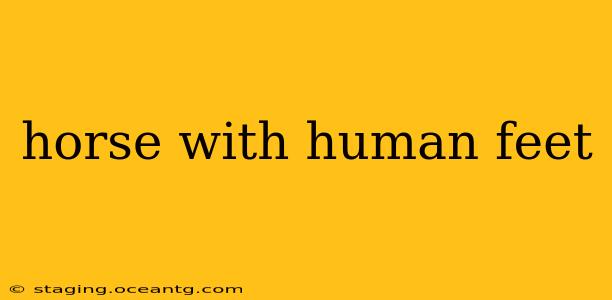The idea of a horse with human feet – a creature blending equine and human anatomy – sparks immediate curiosity. It's a concept that straddles the line between fantasy and scientific possibility, appearing in folklore, art, and even sparking discussions about evolutionary biology. This article will explore the multifaceted nature of this intriguing concept, addressing common questions and delving deeper into the biological impossibilities and imaginative portrayals.
Are there any real horses with human feet?
No, there are no real horses with human feet. The skeletal structure, musculature, and overall biomechanics of horses and humans are fundamentally different. Horses' legs are built for speed, endurance, and weight-bearing, utilizing a unique arrangement of bones and joints unlike anything found in primates. Human feet, on the other hand, are designed for dexterity, balance, and walking upright. The fusion of these vastly different structures would be biologically impossible.
What about mythical creatures with human feet and horse bodies?
Mythology and folklore are rich with creatures that blend human and animal features. Centaurs, for example, are iconic figures in Greek mythology, depicted as beings with the upper body of a human and the lower body of a horse. These creatures represent a symbolic merging of human intellect and animal power, but their existence is firmly within the realm of fantasy. Similar hybrid creatures appear in various cultures, reflecting the human fascination with combining diverse traits to create fantastical beings.
Why do people imagine horses with human feet?
The human imagination thrives on blending familiar elements to create new and intriguing forms. The image of a horse with human feet likely stems from several factors:
- Anthropomorphism: The tendency to attribute human characteristics to animals. We project our own understanding of locomotion and dexterity onto animals, leading to the conceptualization of a horse possessing the sophisticated feet of a human.
- Artistic License: Artists have always been free to explore the boundaries of reality in their creations. The juxtaposition of a horse's body and human feet can create a visually striking and thought-provoking image, used for symbolic effect or purely aesthetic reasons.
- Fantasy and Sci-Fi: In fictional worlds, the rules of biology are often bent or broken, enabling the creation of creatures that defy the limitations of the real world. Horses with human feet frequently appear in fantasy literature, films, and games, serving as unique and compelling characters.
Could genetic engineering create a horse with human feet?
While genetic engineering is a rapidly advancing field, creating a horse with human feet remains highly improbable, if not impossible. The complexity of limb development and the fundamental differences in skeletal and muscular structures would pose insurmountable challenges. Even if individual genes could be manipulated, coordinating the intricate development of an entirely new limb configuration would be incredibly difficult, likely resulting in severe developmental abnormalities.
What are some examples of horses with human feet in media?
Horses with human feet, or creatures inspired by this concept, are not uncommon in various forms of media. While not explicitly depicted with human feet, Centaurs prominently feature in films, books, and games, capturing the essence of a hybrid between human and equine forms. Other artistic interpretations may showcase similar anatomical fusions, often serving symbolic or aesthetic purposes. Specific examples are abundant but require further research based on desired media types.
Conclusion
The concept of a horse with human feet is a fascinating exploration of the interplay between mythology, art, and biological reality. While impossible in the natural world, this imagined creature continues to captivate our imaginations, serving as a potent symbol in various cultural contexts and fueling the creative spirit in fictional realms. Its enduring appeal highlights our fascination with hybrid forms and our ability to push the boundaries of reality through artistic expression and imaginative storytelling.
